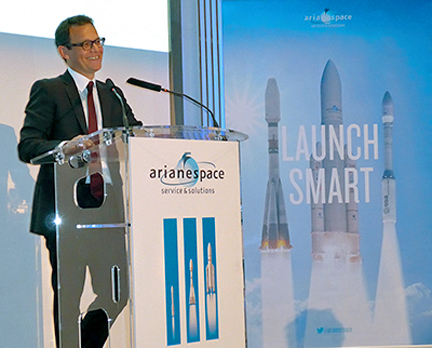
[SatNews] Building on its record year of mission operations in 2014—and supported by European decisions to develop the heavy-lift successor Ariane 6, as well as an enhanced lightweight Vega C vehicle—Arianespace is looking to the future with confidence as a leader in the launch services marketplace.
Speaking to reporters during the company’s traditional New Year’s press conference in Paris, Chairman and CEO Stéphane Israël underscored Arianespace’s ability to deliver for its customers in 2014, which is to continue with an intense 12-month schedule of launches in 2015.

Addressing international journalists at his New Year’s press conference, Chairman and CEO Stéphane Israël outlined Ariane 6’s advantages as the successor to the company’s workhorse Ariane 5.
Photo courtesy of Arianespace.
“We are targeting another record year of missions, while continuing our pursuit of commercial activities to further expand the order book,” he said. “This follows a milestone 2014 from the operational point of view, along with the important actions to ensure the future of European launchers.”
Israël noted that Arianespace contributed to preparing the framework for Europe’s decision on Ariane 6 as the successor to its workhorse Ariane 5. This included the company’s market survey that confirmed major trends in satellite payload size and configuration, as well as Arianespace’s role in the Ariane 6 project’s finalization and the consensus that enabled the go-ahead at a European Space Agency ministerial-level meeting. He added that Ariane 6’s advantages include its competitive launch prices, flexibility in meeting future payload lift requirements, and synergy with Arianespace’s launcher family concept.
Referred to as the Ariane 6 modular, this follow-on launcher is envisioned in two configurations: an “institutional” version, incorporating a core stage containing liquid oxygen and hydrogen, along with two solid propellant boosters and an upper stage, offering a five-metric-ton payload lift performance to geostationary transfer orbit (GTO); and a “commercial” version providing 10.5 metric tons of payload lift to GTO, equipped with the core stage, four solid propellant boosters and an upper stage.
Israël explained that five missions are anticipated annually for the “institutional” Ariane 6 with Europe’s engagement, along with the objective of performing six launches per year with the “commercial” configuration. “Ariane 6 underscores the firm commitment of Europe to maintain its space leadership, even in times of pressure on finances,” he added.
The solid propellant boosters to be used on Ariane 6 will be common with Vega C—the evolved version of Arianespace’s current lightweight Vega vehicle. “This provides further synergy with our launcher family concept and the mission operations at French Guiana, while also contributing production synergy,” Israël told reporters.
He said Arianespace and Europe will evaluate the possibility of re-usability for Ariane 6, but stated that the potential cost benefits must be weighed against challenges that include reduced performance due to the increased weight of recovery systems, the costs for refurbishment of a reusable stage and its propulsion system, as well as the prospect of effects on launch rate and reliability.
Arianespace’s mission requirements through 2019 are covered by the total 58 launchers on order with European industry, composed of 32 Ariane 5s, 13 Soyuz vehicles and 13 Vegas.
Follow Arianespace's by visiting the company's infosite: http://www.arianespace.com.

